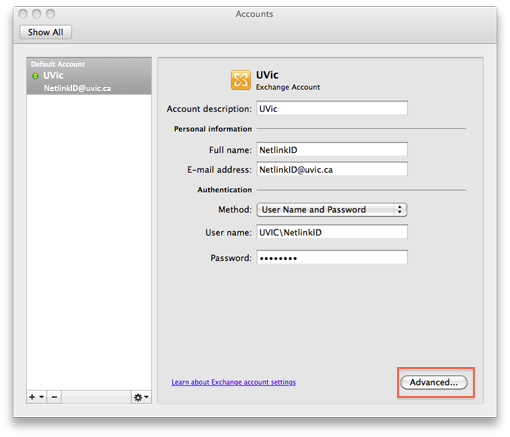Exchange Outlook For Mac
.Note: If you have not previously opened Outlook you will be provided with a welcome screen.From here click Add Account, select Exchange, then skip to step 4.
Outlook for Mac does not support Auto-mapping of shared mailboxes. A folder is shared with you. If another user has shared an inbox, primary calendar folder, or primary contact folder with you, use this method to open the user's folder. Full Access permission of a mailbox set up through Exchange Admin Center (EAC)—you can add the shared. Get time back when you’re all caught up with what’s new in your Focused Inbox. Free with Outlook for iOS Connect. Get things done on the go with Outlook mobile. Work efficiently with email, calendar, contacts, tasks, and more—together in one place. Office integration lets you share. Outlook 2016 for Mac, Outlook for Mac for Office 365; In this article. Original KB number: 2649169. Consider the following scenario: You try to transfer data from Outlook 2016 for Mac or Outlook for Mac 2011, such as email and contacts, to Outlook for Windows. To do this, you try to import the.olm file that was exported from Outlook. Start quickly with the most recent versions of Word, Excel, PowerPoint, Outlook, OneNote and OneDrive —combining the familiarity of Office and the unique Mac features you love. Work online or offline, on your own or with others in real time—whatever works for what you’re doing.
-->Original KB number: 3009176
Symptoms
After you migrate to Microsoft Outlook 2016 for Mac from Outlook for Mac 2011, you notice that the category colors that are assigned to your categories are changed.
Cause
Outlook for Mac 2011 uses a local list of categories. The names of these categories are synchronized to the server that's running Microsoft Exchange Server when they're assigned to items. This makes the names visible on different clients and devices. However, the colors for these categories aren't synchronized to Exchange.
Outlook 2016 for Mac uses the Master Category List (MCL) that's stored on the Exchange server to synchronize the category names and colors.
So when you migrate from Outlook for Mac 2011 to Outlook 2016 for Mac, any local category names that are assigned to items are merged with the MCL. Random colors are assigned to these categories because the colors from Outlook for Mac 2011 aren't synchronized.
Resolution
Update the colors that are assigned to categories in the MCL in Outlook 2016 for Mac. To do this, follow these steps:
- On the Home ribbon, click Categorize > Edit Categories.
- If you have more than one account that's added to Outlook 2016 for Mac, make sure that the correct Exchange account is selected.
- For each category for which you want to change the color, click the color block, and then select the color that you want.
- Make any additional changes that you want by changing the names of categories and by adding or removing categories, as appropriate.
- Close the Categories window.

The changes that you make should be saved in the MCL and should be viewable from other clients and devices.
More information
In Outlook for Mac 2011, thousands of colors can be assigned to local categories. In Outlook 2016 for Mac, 25 predefined colors can be assigned to MCL categories. These colors are predefined by the Exchange server MCL.
If you have an IMAP or POP account that's set up in Outlook 2016 for Mac, local categories are used. So you can select from thousands of colors for these categories.
 -->
-->Original KB number: 2649169
Summary
Consider the following scenario:
You try to transfer data from Outlook 2016 for Mac or Outlook for Mac 2011, such as email and contacts, to Outlook for Windows. To do this, you try to import the .olm file that was exported from Outlook for Mac. However, you receive the following error in Outlook for Windows:
The file <path>.olm is not an Outlook data file (.pst).
More information

Microsoft Outlook for Windows doesn't support .olm data files. However, there are several methods that you can use to transfer data from Outlook for Mac to a Windows-based Outlook client. These methods require that you use Microsoft Exchange Server.
Synchronize data with Microsoft Exchange Server
If the data is available in a mailbox that is located on an Exchange Server, the Outlook for Windows client can access the data. To do this, the Windows client connects to the Exchange Server by using either Cached Exchange Mode or Online mode.
Export data from Microsoft Exchange to an Outlook data (.pst) file
Use the Export-Mailbox shell cmdlet from Microsoft Exchange PowerShell to export mailbox data to an Outlook data (.pst) file. For more information about the Export-Mailbox shell cmdlet, see:

Note
Exchange Outlook For Mac Osx
Currently, Microsoft does not have a utility to convert an .olm file to a .pst file.
